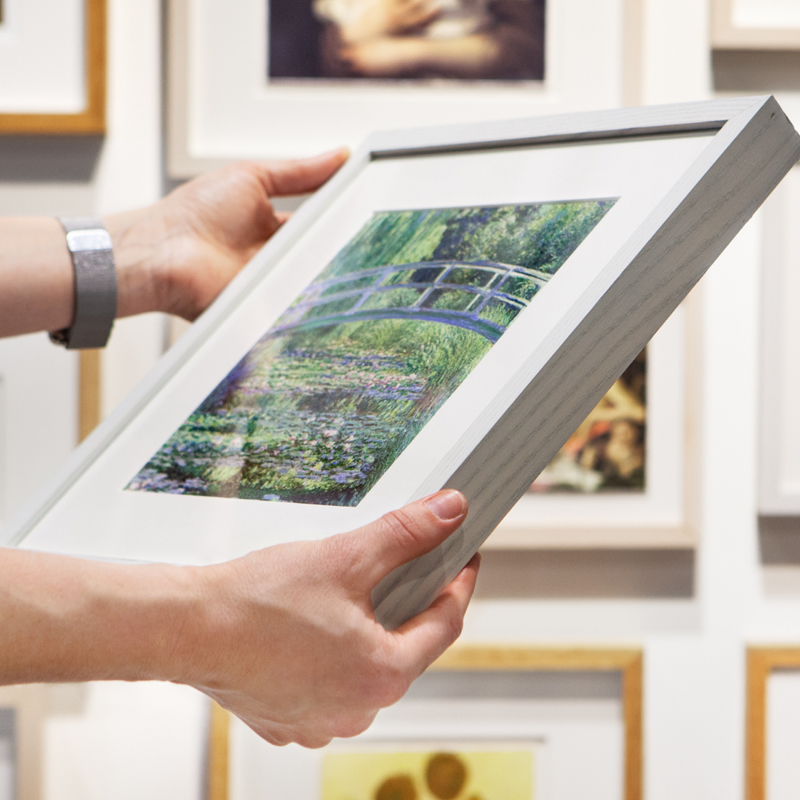Francisco de Zurbarán, 'A Cup of Water and a Rose', about 1630
About the work
Overview
In this small and intimate painting, everyday objects appear monumental and take on a mystical intensity. On a tabletop or ledge, a ceramic cup of water with delicately curved handles sits in the centre of a silver plate. A thornless rose in full bloom balances on the plate’s edge.
That these objects have religious significance would have been immediately obvious to devout Spanish viewers in the seventeenth century. The cup of water and the rose were seen as symbols of the Virgin Mary’s purity; the fact that the flower is thornless may refer to the Immaculate Conception (the belief that Mary was conceived without sin).
Zurbarán’s painting encourages meditation and quiet contemplation; an approach not dissimilar to that which he adopted in his religious paintings. The stark simplicity of the surrounding space provides no distractions, and we are invited to appreciate the beauty of light reflecting on water and bouncing off polished surfaces.
Key facts
Details
- Full title
- A Cup of Water and a Rose
- Artist
- Francisco de Zurbarán
- Artist dates
- 1598 - 1664
- Date made
- About 1630
- Medium and support
- Oil on canvas
- Dimensions
- 21.2 × 30.1 cm
- Acquisition credit
- Bought for the National Gallery by the George Beaumont Group, 1997
- Inventory number
- NG6566
- Location
- Room 25
- Collection
- Main Collection
- Frame
- 17th-century Spanish Frame
Provenance
Additional information
This painting is included in a list of works with incomplete provenance from 1933–1945; for more information see Whereabouts of paintings 1933–1945.
Text extracted from the National Gallery’s Annual Report, ‘The National Gallery Report: April 1996 – March 1997’.
Exhibition history
-
2008Picasso et les MaîtresGaleries Nationales du Grand Palais8 October 2008 - 2 February 2009
-
2013Francisco de ZurbaránPalazzo dei Diamanti15 September 2013 - 6 January 2014Centre for Fine Arts (BOZAR)29 January 2014 - 25 May 2014
-
2014Kenneth ClarkTate Britain19 May 2014 - 10 August 2014
-
2018Tacita Dean: STILL LIFEThe National Gallery (London)15 March 2018 - 28 May 2018
-
2019Rembrandt-VelázquezRijksmuseum Amsterdam11 October 2019 - 19 January 2020
-
2021The Director's Choice: Lizards, Fancy Feathered Hats and TrickeryThe National Gallery (London)5 May 2021 - 9999
Bibliography
-
1938Tomas Harris Ltd, From Greco to Goya: Illustrated Souvenir of an Exhibition Organized by Tomas Harris ltd. In Aid of the British Red Cross Society's Spanish Relief Fund (exh. cat. Spanish Art Gallery, 1938), Brussels 1938
-
1946H.P.G. Seckel, 'Francisco de Zurbarán: As a Painter of Still Life', Gazette des beaux-arts, VI/30, 1946, pp. 279-300
-
1947H.P.G. Seckel, 'Francisco de Zurbarán: As a Painter of Still Life', Gazette des beaux-arts, VI/31, 1947, pp. 61-2
-
1958C. Pemán, 'Juan de Zurbarán', Archivo español de arte, XXXI, 1958, pp. 193-211
-
1994M.L. Caturla and O. Delenda, Francisco de Zurbarán, Paris 1994
-
1995W.B. Jordan and P. Cherry, Spanish Still Life from Velázquez to Goya, (exh. cat. The National Gallery, 22 February - 21 May 1995), London 1995
-
1997National Gallery, The National Gallery Report: April 1996 - March 1997, London 1997
-
1997W.B. Jordan, An Eye on Nature: Spanish Still-Life Paintings from Sánchez Cotán to Goya, London 1997
-
1998G. Finaldi, 'A Zurbarán for the National Gallery', Gazette des beaux-arts, CXL/132, 1998, pp. 139-48
-
2000F. Scheffler, Das spanische Stilleben des 17. Jahrhunderts: Theorie, Genese und Entfaltung einer neuen Bildgattung, Frankfurt am Main 2000
-
2001
C. Baker and T. Henry, The National Gallery: Complete Illustrated Catalogue, London 2001
-
2002F.C. Serraller, Flores españolas del Siglo de Oro: La pintura de flores en la España del siglo XVII (exh. cat. Museo Nacional del Prado, 15 November 2002 - 2 February 2003), Madrid 2002
-
2003A. Moore and C. Garibaldi, Flower Power: The Meaning of Flowers in Art (exh. cat. Norwich Castle Museum & Art Gallery, 3 February - 5 May 2003; Millennium Galleries, 24 May - 25 August 2003), London 2003
-
2009D. Carr, El Greco to Goya: Spanish Painting, London 2009
About this record
If you know more about this work or have spotted an error, please contact us. Please note that exhibition histories are listed from 2009 onwards. Bibliographies may not be complete; more comprehensive information is available in the National Gallery Library.




